Analysis of Corporate Social Responsibility: A Literature Review
VerifiedAdded on 2020/10/22
|10
|2574
|303
Report
AI Summary
This report presents a comprehensive literature review on Corporate Social Responsibility (CSR), exploring its definition, purpose, and key issues. It examines various perspectives on CSR, including the sceptic, utopian, and realistic views, and discusses the benefits of CSR for businesses, such as improved brand image, customer loyalty, and employee satisfaction. The report covers the evolution of CSR trends and their impact on society and business. Key issues such as human rights, working conditions, environmental management, information disclosure, corporate governance, consumer interests, and taxation are analyzed. The report concludes that CSR is crucial for creating a positive impact, building reputation, and achieving sustainable business practices, offering benefits like customer and employee satisfaction, and long-term sustainability. The report references several scholarly articles to support its findings and recommendations.

Study skill for highter
education
education
Paraphrase This Document
Need a fresh take? Get an instant paraphrase of this document with our AI Paraphraser
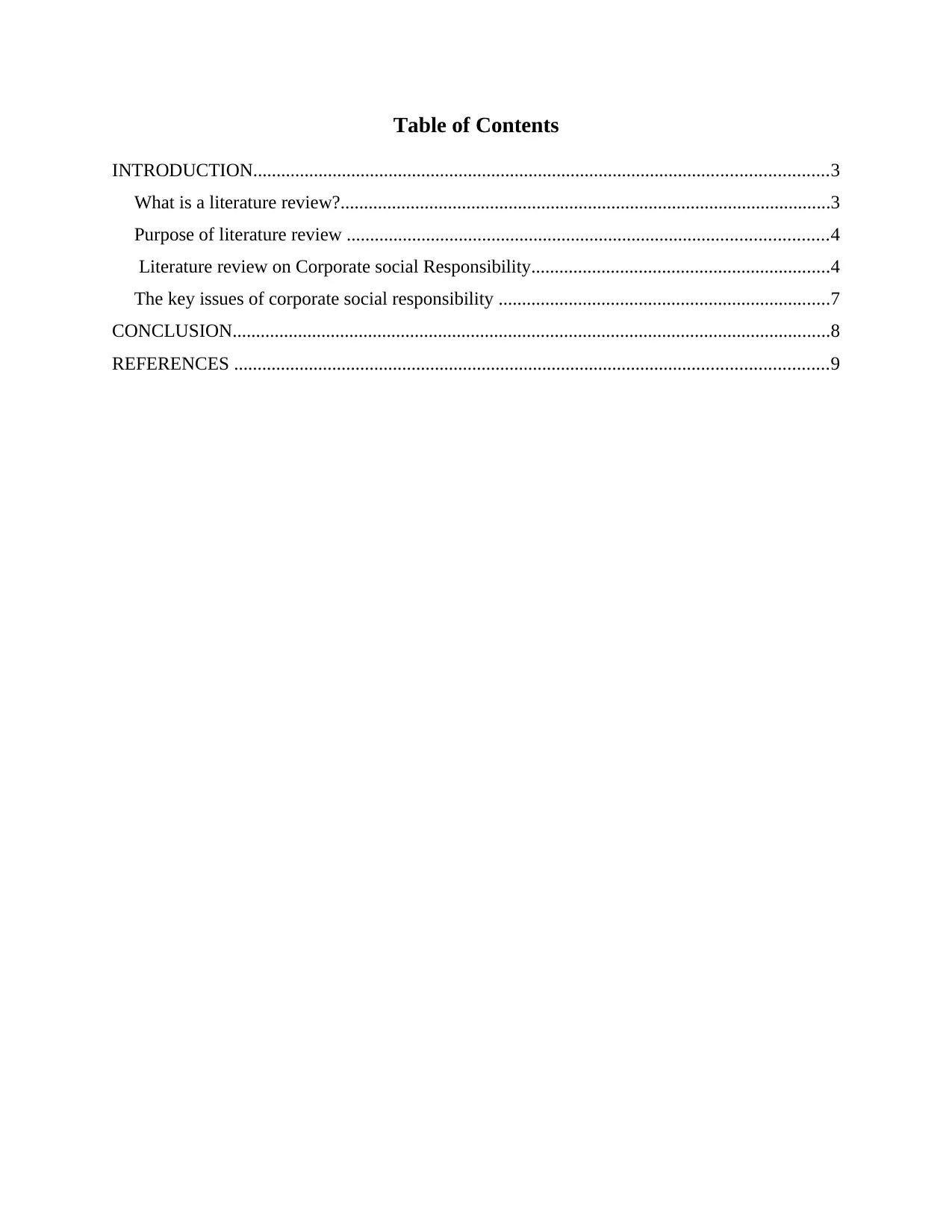
Table of Contents
INTRODUCTION...........................................................................................................................3
What is a literature review?.........................................................................................................3
Purpose of literature review .......................................................................................................4
Literature review on Corporate social Responsibility................................................................4
The key issues of corporate social responsibility .......................................................................7
CONCLUSION................................................................................................................................8
REFERENCES ...............................................................................................................................9
INTRODUCTION...........................................................................................................................3
What is a literature review?.........................................................................................................3
Purpose of literature review .......................................................................................................4
Literature review on Corporate social Responsibility................................................................4
The key issues of corporate social responsibility .......................................................................7
CONCLUSION................................................................................................................................8
REFERENCES ...............................................................................................................................9
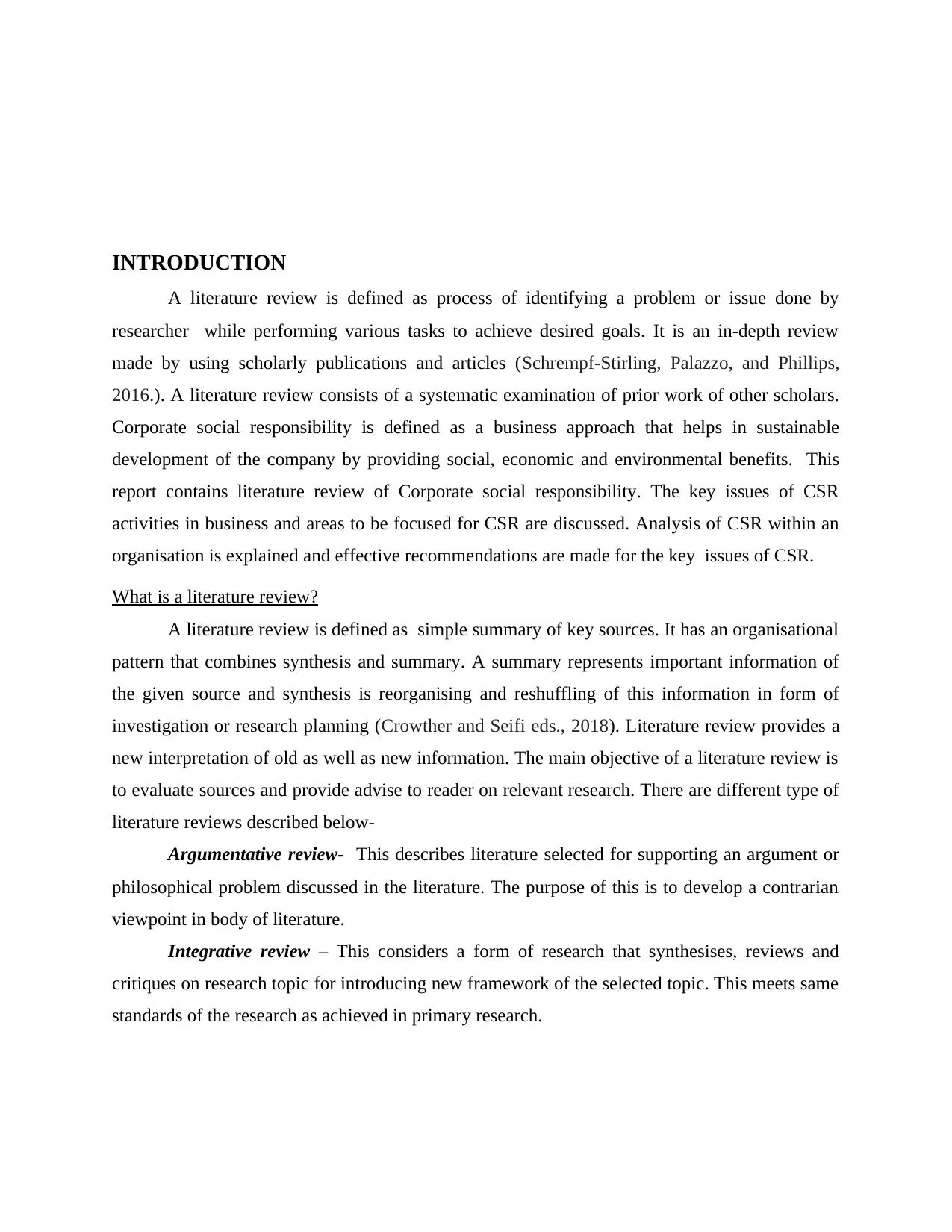
INTRODUCTION
A literature review is defined as process of identifying a problem or issue done by
researcher while performing various tasks to achieve desired goals. It is an in-depth review
made by using scholarly publications and articles (Schrempf-Stirling, Palazzo, and Phillips,
2016.). A literature review consists of a systematic examination of prior work of other scholars.
Corporate social responsibility is defined as a business approach that helps in sustainable
development of the company by providing social, economic and environmental benefits. This
report contains literature review of Corporate social responsibility. The key issues of CSR
activities in business and areas to be focused for CSR are discussed. Analysis of CSR within an
organisation is explained and effective recommendations are made for the key issues of CSR.
What is a literature review?
A literature review is defined as simple summary of key sources. It has an organisational
pattern that combines synthesis and summary. A summary represents important information of
the given source and synthesis is reorganising and reshuffling of this information in form of
investigation or research planning (Crowther and Seifi eds., 2018). Literature review provides a
new interpretation of old as well as new information. The main objective of a literature review is
to evaluate sources and provide advise to reader on relevant research. There are different type of
literature reviews described below-
Argumentative review- This describes literature selected for supporting an argument or
philosophical problem discussed in the literature. The purpose of this is to develop a contrarian
viewpoint in body of literature.
Integrative review – This considers a form of research that synthesises, reviews and
critiques on research topic for introducing new framework of the selected topic. This meets same
standards of the research as achieved in primary research.
A literature review is defined as process of identifying a problem or issue done by
researcher while performing various tasks to achieve desired goals. It is an in-depth review
made by using scholarly publications and articles (Schrempf-Stirling, Palazzo, and Phillips,
2016.). A literature review consists of a systematic examination of prior work of other scholars.
Corporate social responsibility is defined as a business approach that helps in sustainable
development of the company by providing social, economic and environmental benefits. This
report contains literature review of Corporate social responsibility. The key issues of CSR
activities in business and areas to be focused for CSR are discussed. Analysis of CSR within an
organisation is explained and effective recommendations are made for the key issues of CSR.
What is a literature review?
A literature review is defined as simple summary of key sources. It has an organisational
pattern that combines synthesis and summary. A summary represents important information of
the given source and synthesis is reorganising and reshuffling of this information in form of
investigation or research planning (Crowther and Seifi eds., 2018). Literature review provides a
new interpretation of old as well as new information. The main objective of a literature review is
to evaluate sources and provide advise to reader on relevant research. There are different type of
literature reviews described below-
Argumentative review- This describes literature selected for supporting an argument or
philosophical problem discussed in the literature. The purpose of this is to develop a contrarian
viewpoint in body of literature.
Integrative review – This considers a form of research that synthesises, reviews and
critiques on research topic for introducing new framework of the selected topic. This meets same
standards of the research as achieved in primary research.
⊘ This is a preview!⊘
Do you want full access?
Subscribe today to unlock all pages.

Trusted by 1+ million students worldwide

Methodological review – This includes various methods for analysing framework of
research at various levels like sampling, quantitative and qualitative integration, data collection,
data analysis and ontological consideration.
Historical review – This focuses on examining research from starting level to end level.
The main purpose for placing historical research is to identify directions for future research.
Systematic review- This includes an overview of the existing evidence and clear research
questions. These questions uses standard methods for identifying relevant research, scientifically
summarize the research about clear research questions.
Theoretical review - The main purpose of theoretical review is to examine core of theory
that has been collected in regards to concept, theory, phenomena and issues (Lins, Servaes and
Tamayo, 2017). This helps in establishing theories which are already existing and relationship
between them.
Purpose of literature review
The purpose of literature review are given below-
To understand the concept of research problem thoroughly and place every work in
context of contribution.
To explain relationship of work and other consideration.
To know about any gaps that exist in the literature.
To estimate new ways for interpreting prior research.
To identify areas of prior scholarship for preventing duplication.
To fulfil needs for an additional research.
To locate research within context of existing literature.
Literature review on Corporate social Responsibility
According to (Meijer and Bolívar, 2016), It has been analysed that Corporate social
responsibility is a process by which a firm approaches its environment. There are certain
expectations of society from business and therefore it is the responsibility of organisations to
take some measures for development of society. Business and society are interwoven. There are
three types of CSR naming sceptic view, utopian view and realist view.
Sceptic view- This view demonstrates that the notion of CSR is opposed to freedom and
democracy that disturbs focus of business on creating wealth. Milton Friedman defines this
research at various levels like sampling, quantitative and qualitative integration, data collection,
data analysis and ontological consideration.
Historical review – This focuses on examining research from starting level to end level.
The main purpose for placing historical research is to identify directions for future research.
Systematic review- This includes an overview of the existing evidence and clear research
questions. These questions uses standard methods for identifying relevant research, scientifically
summarize the research about clear research questions.
Theoretical review - The main purpose of theoretical review is to examine core of theory
that has been collected in regards to concept, theory, phenomena and issues (Lins, Servaes and
Tamayo, 2017). This helps in establishing theories which are already existing and relationship
between them.
Purpose of literature review
The purpose of literature review are given below-
To understand the concept of research problem thoroughly and place every work in
context of contribution.
To explain relationship of work and other consideration.
To know about any gaps that exist in the literature.
To estimate new ways for interpreting prior research.
To identify areas of prior scholarship for preventing duplication.
To fulfil needs for an additional research.
To locate research within context of existing literature.
Literature review on Corporate social Responsibility
According to (Meijer and Bolívar, 2016), It has been analysed that Corporate social
responsibility is a process by which a firm approaches its environment. There are certain
expectations of society from business and therefore it is the responsibility of organisations to
take some measures for development of society. Business and society are interwoven. There are
three types of CSR naming sceptic view, utopian view and realist view.
Sceptic view- This view demonstrates that the notion of CSR is opposed to freedom and
democracy that disturbs focus of business on creating wealth. Milton Friedman defines this
Paraphrase This Document
Need a fresh take? Get an instant paraphrase of this document with our AI Paraphraser
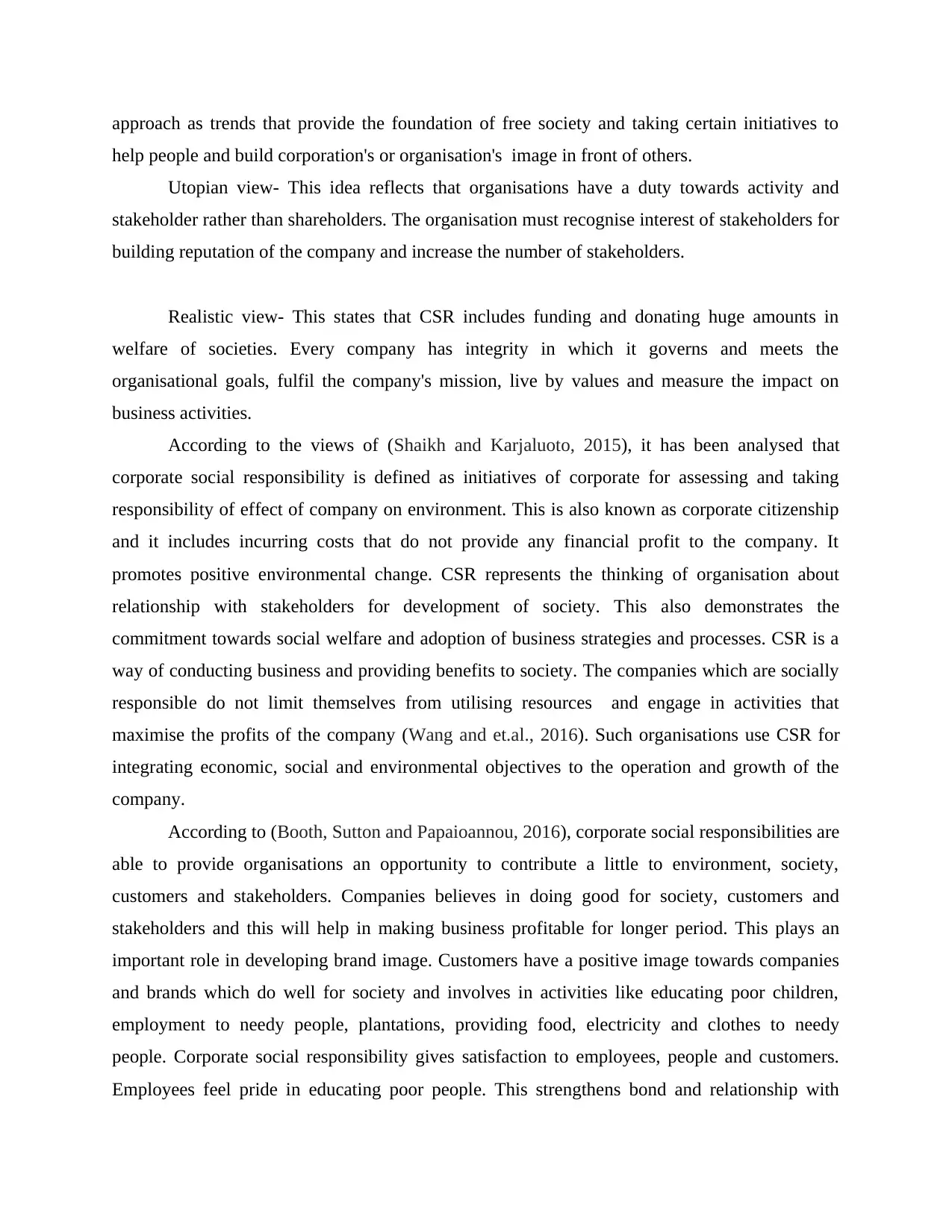
approach as trends that provide the foundation of free society and taking certain initiatives to
help people and build corporation's or organisation's image in front of others.
Utopian view- This idea reflects that organisations have a duty towards activity and
stakeholder rather than shareholders. The organisation must recognise interest of stakeholders for
building reputation of the company and increase the number of stakeholders.
Realistic view- This states that CSR includes funding and donating huge amounts in
welfare of societies. Every company has integrity in which it governs and meets the
organisational goals, fulfil the company's mission, live by values and measure the impact on
business activities.
According to the views of (Shaikh and Karjaluoto, 2015), it has been analysed that
corporate social responsibility is defined as initiatives of corporate for assessing and taking
responsibility of effect of company on environment. This is also known as corporate citizenship
and it includes incurring costs that do not provide any financial profit to the company. It
promotes positive environmental change. CSR represents the thinking of organisation about
relationship with stakeholders for development of society. This also demonstrates the
commitment towards social welfare and adoption of business strategies and processes. CSR is a
way of conducting business and providing benefits to society. The companies which are socially
responsible do not limit themselves from utilising resources and engage in activities that
maximise the profits of the company (Wang and et.al., 2016). Such organisations use CSR for
integrating economic, social and environmental objectives to the operation and growth of the
company.
According to (Booth, Sutton and Papaioannou, 2016), corporate social responsibilities are
able to provide organisations an opportunity to contribute a little to environment, society,
customers and stakeholders. Companies believes in doing good for society, customers and
stakeholders and this will help in making business profitable for longer period. This plays an
important role in developing brand image. Customers have a positive image towards companies
and brands which do well for society and involves in activities like educating poor children,
employment to needy people, plantations, providing food, electricity and clothes to needy
people. Corporate social responsibility gives satisfaction to employees, people and customers.
Employees feel pride in educating poor people. This strengthens bond and relationship with
help people and build corporation's or organisation's image in front of others.
Utopian view- This idea reflects that organisations have a duty towards activity and
stakeholder rather than shareholders. The organisation must recognise interest of stakeholders for
building reputation of the company and increase the number of stakeholders.
Realistic view- This states that CSR includes funding and donating huge amounts in
welfare of societies. Every company has integrity in which it governs and meets the
organisational goals, fulfil the company's mission, live by values and measure the impact on
business activities.
According to the views of (Shaikh and Karjaluoto, 2015), it has been analysed that
corporate social responsibility is defined as initiatives of corporate for assessing and taking
responsibility of effect of company on environment. This is also known as corporate citizenship
and it includes incurring costs that do not provide any financial profit to the company. It
promotes positive environmental change. CSR represents the thinking of organisation about
relationship with stakeholders for development of society. This also demonstrates the
commitment towards social welfare and adoption of business strategies and processes. CSR is a
way of conducting business and providing benefits to society. The companies which are socially
responsible do not limit themselves from utilising resources and engage in activities that
maximise the profits of the company (Wang and et.al., 2016). Such organisations use CSR for
integrating economic, social and environmental objectives to the operation and growth of the
company.
According to (Booth, Sutton and Papaioannou, 2016), corporate social responsibilities are
able to provide organisations an opportunity to contribute a little to environment, society,
customers and stakeholders. Companies believes in doing good for society, customers and
stakeholders and this will help in making business profitable for longer period. This plays an
important role in developing brand image. Customers have a positive image towards companies
and brands which do well for society and involves in activities like educating poor children,
employment to needy people, plantations, providing food, electricity and clothes to needy
people. Corporate social responsibility gives satisfaction to employees, people and customers.
Employees feel pride in educating poor people. This strengthens bond and relationship with
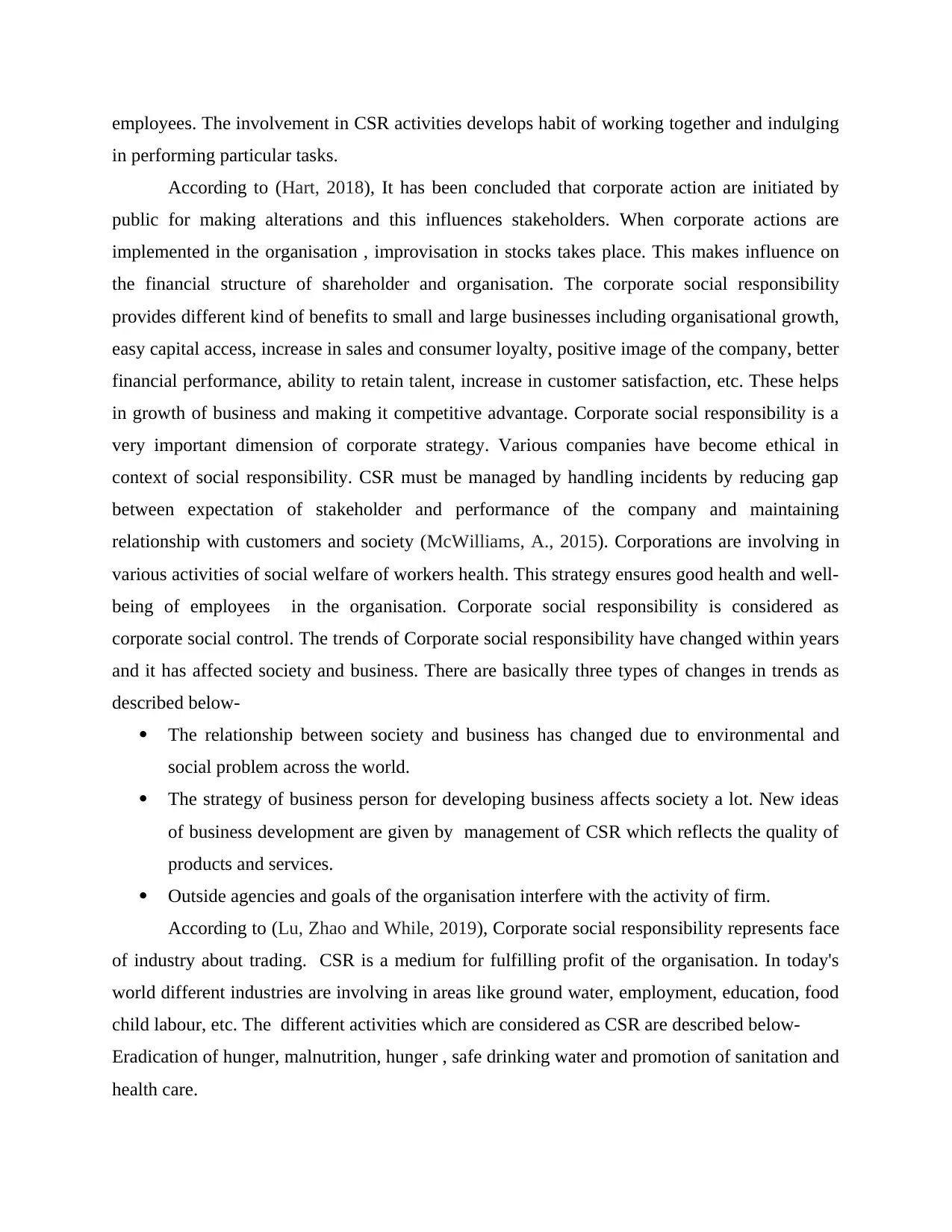
employees. The involvement in CSR activities develops habit of working together and indulging
in performing particular tasks.
According to (Hart, 2018), It has been concluded that corporate action are initiated by
public for making alterations and this influences stakeholders. When corporate actions are
implemented in the organisation , improvisation in stocks takes place. This makes influence on
the financial structure of shareholder and organisation. The corporate social responsibility
provides different kind of benefits to small and large businesses including organisational growth,
easy capital access, increase in sales and consumer loyalty, positive image of the company, better
financial performance, ability to retain talent, increase in customer satisfaction, etc. These helps
in growth of business and making it competitive advantage. Corporate social responsibility is a
very important dimension of corporate strategy. Various companies have become ethical in
context of social responsibility. CSR must be managed by handling incidents by reducing gap
between expectation of stakeholder and performance of the company and maintaining
relationship with customers and society (McWilliams, A., 2015). Corporations are involving in
various activities of social welfare of workers health. This strategy ensures good health and well-
being of employees in the organisation. Corporate social responsibility is considered as
corporate social control. The trends of Corporate social responsibility have changed within years
and it has affected society and business. There are basically three types of changes in trends as
described below-
The relationship between society and business has changed due to environmental and
social problem across the world.
The strategy of business person for developing business affects society a lot. New ideas
of business development are given by management of CSR which reflects the quality of
products and services.
Outside agencies and goals of the organisation interfere with the activity of firm.
According to (Lu, Zhao and While, 2019), Corporate social responsibility represents face
of industry about trading. CSR is a medium for fulfilling profit of the organisation. In today's
world different industries are involving in areas like ground water, employment, education, food
child labour, etc. The different activities which are considered as CSR are described below-
Eradication of hunger, malnutrition, hunger , safe drinking water and promotion of sanitation and
health care.
in performing particular tasks.
According to (Hart, 2018), It has been concluded that corporate action are initiated by
public for making alterations and this influences stakeholders. When corporate actions are
implemented in the organisation , improvisation in stocks takes place. This makes influence on
the financial structure of shareholder and organisation. The corporate social responsibility
provides different kind of benefits to small and large businesses including organisational growth,
easy capital access, increase in sales and consumer loyalty, positive image of the company, better
financial performance, ability to retain talent, increase in customer satisfaction, etc. These helps
in growth of business and making it competitive advantage. Corporate social responsibility is a
very important dimension of corporate strategy. Various companies have become ethical in
context of social responsibility. CSR must be managed by handling incidents by reducing gap
between expectation of stakeholder and performance of the company and maintaining
relationship with customers and society (McWilliams, A., 2015). Corporations are involving in
various activities of social welfare of workers health. This strategy ensures good health and well-
being of employees in the organisation. Corporate social responsibility is considered as
corporate social control. The trends of Corporate social responsibility have changed within years
and it has affected society and business. There are basically three types of changes in trends as
described below-
The relationship between society and business has changed due to environmental and
social problem across the world.
The strategy of business person for developing business affects society a lot. New ideas
of business development are given by management of CSR which reflects the quality of
products and services.
Outside agencies and goals of the organisation interfere with the activity of firm.
According to (Lu, Zhao and While, 2019), Corporate social responsibility represents face
of industry about trading. CSR is a medium for fulfilling profit of the organisation. In today's
world different industries are involving in areas like ground water, employment, education, food
child labour, etc. The different activities which are considered as CSR are described below-
Eradication of hunger, malnutrition, hunger , safe drinking water and promotion of sanitation and
health care.
⊘ This is a preview!⊘
Do you want full access?
Subscribe today to unlock all pages.

Trusted by 1+ million students worldwide
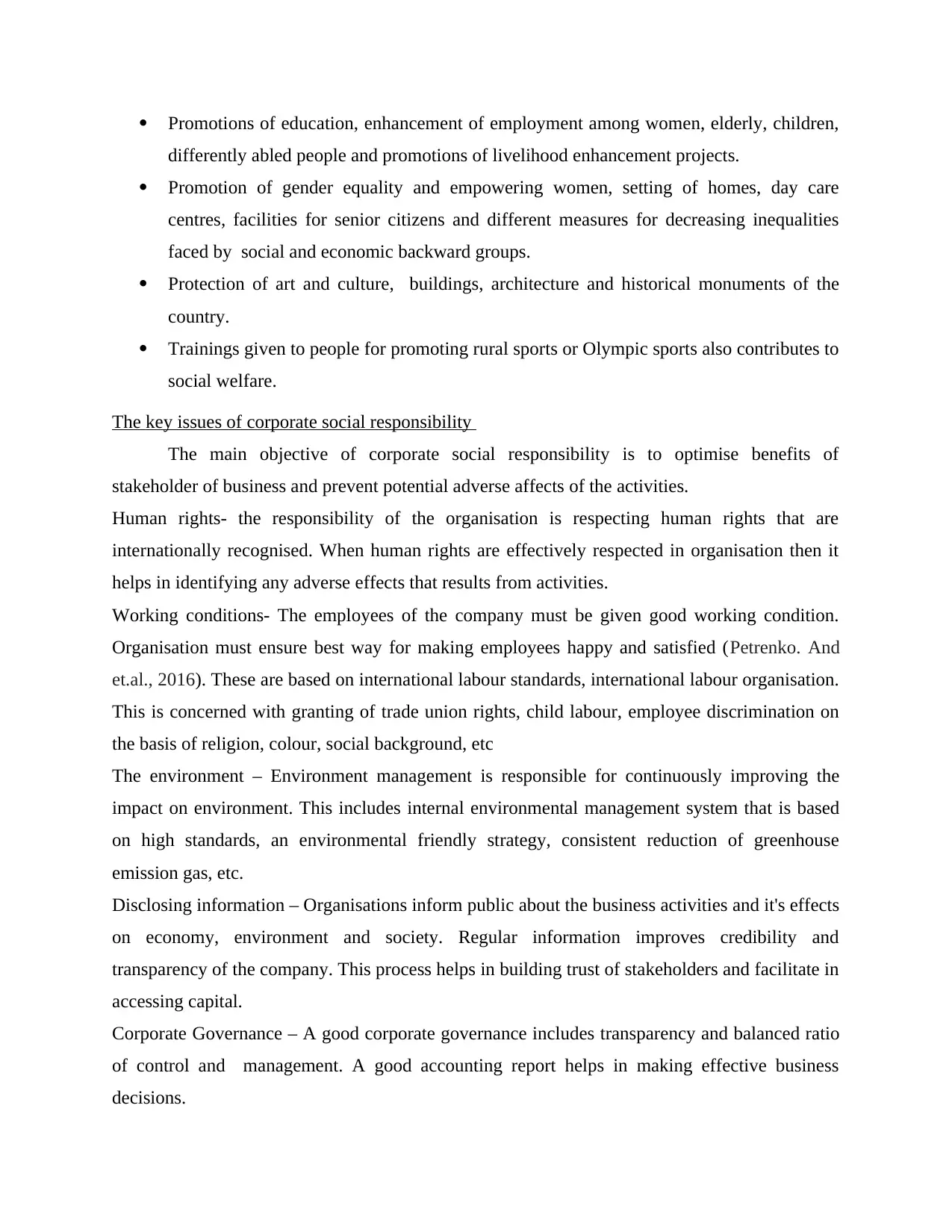
Promotions of education, enhancement of employment among women, elderly, children,
differently abled people and promotions of livelihood enhancement projects.
Promotion of gender equality and empowering women, setting of homes, day care
centres, facilities for senior citizens and different measures for decreasing inequalities
faced by social and economic backward groups.
Protection of art and culture, buildings, architecture and historical monuments of the
country.
Trainings given to people for promoting rural sports or Olympic sports also contributes to
social welfare.
The key issues of corporate social responsibility
The main objective of corporate social responsibility is to optimise benefits of
stakeholder of business and prevent potential adverse affects of the activities.
Human rights- the responsibility of the organisation is respecting human rights that are
internationally recognised. When human rights are effectively respected in organisation then it
helps in identifying any adverse effects that results from activities.
Working conditions- The employees of the company must be given good working condition.
Organisation must ensure best way for making employees happy and satisfied (Petrenko. And
et.al., 2016). These are based on international labour standards, international labour organisation.
This is concerned with granting of trade union rights, child labour, employee discrimination on
the basis of religion, colour, social background, etc
The environment – Environment management is responsible for continuously improving the
impact on environment. This includes internal environmental management system that is based
on high standards, an environmental friendly strategy, consistent reduction of greenhouse
emission gas, etc.
Disclosing information – Organisations inform public about the business activities and it's effects
on economy, environment and society. Regular information improves credibility and
transparency of the company. This process helps in building trust of stakeholders and facilitate in
accessing capital.
Corporate Governance – A good corporate governance includes transparency and balanced ratio
of control and management. A good accounting report helps in making effective business
decisions.
differently abled people and promotions of livelihood enhancement projects.
Promotion of gender equality and empowering women, setting of homes, day care
centres, facilities for senior citizens and different measures for decreasing inequalities
faced by social and economic backward groups.
Protection of art and culture, buildings, architecture and historical monuments of the
country.
Trainings given to people for promoting rural sports or Olympic sports also contributes to
social welfare.
The key issues of corporate social responsibility
The main objective of corporate social responsibility is to optimise benefits of
stakeholder of business and prevent potential adverse affects of the activities.
Human rights- the responsibility of the organisation is respecting human rights that are
internationally recognised. When human rights are effectively respected in organisation then it
helps in identifying any adverse effects that results from activities.
Working conditions- The employees of the company must be given good working condition.
Organisation must ensure best way for making employees happy and satisfied (Petrenko. And
et.al., 2016). These are based on international labour standards, international labour organisation.
This is concerned with granting of trade union rights, child labour, employee discrimination on
the basis of religion, colour, social background, etc
The environment – Environment management is responsible for continuously improving the
impact on environment. This includes internal environmental management system that is based
on high standards, an environmental friendly strategy, consistent reduction of greenhouse
emission gas, etc.
Disclosing information – Organisations inform public about the business activities and it's effects
on economy, environment and society. Regular information improves credibility and
transparency of the company. This process helps in building trust of stakeholders and facilitate in
accessing capital.
Corporate Governance – A good corporate governance includes transparency and balanced ratio
of control and management. A good accounting report helps in making effective business
decisions.
Paraphrase This Document
Need a fresh take? Get an instant paraphrase of this document with our AI Paraphraser
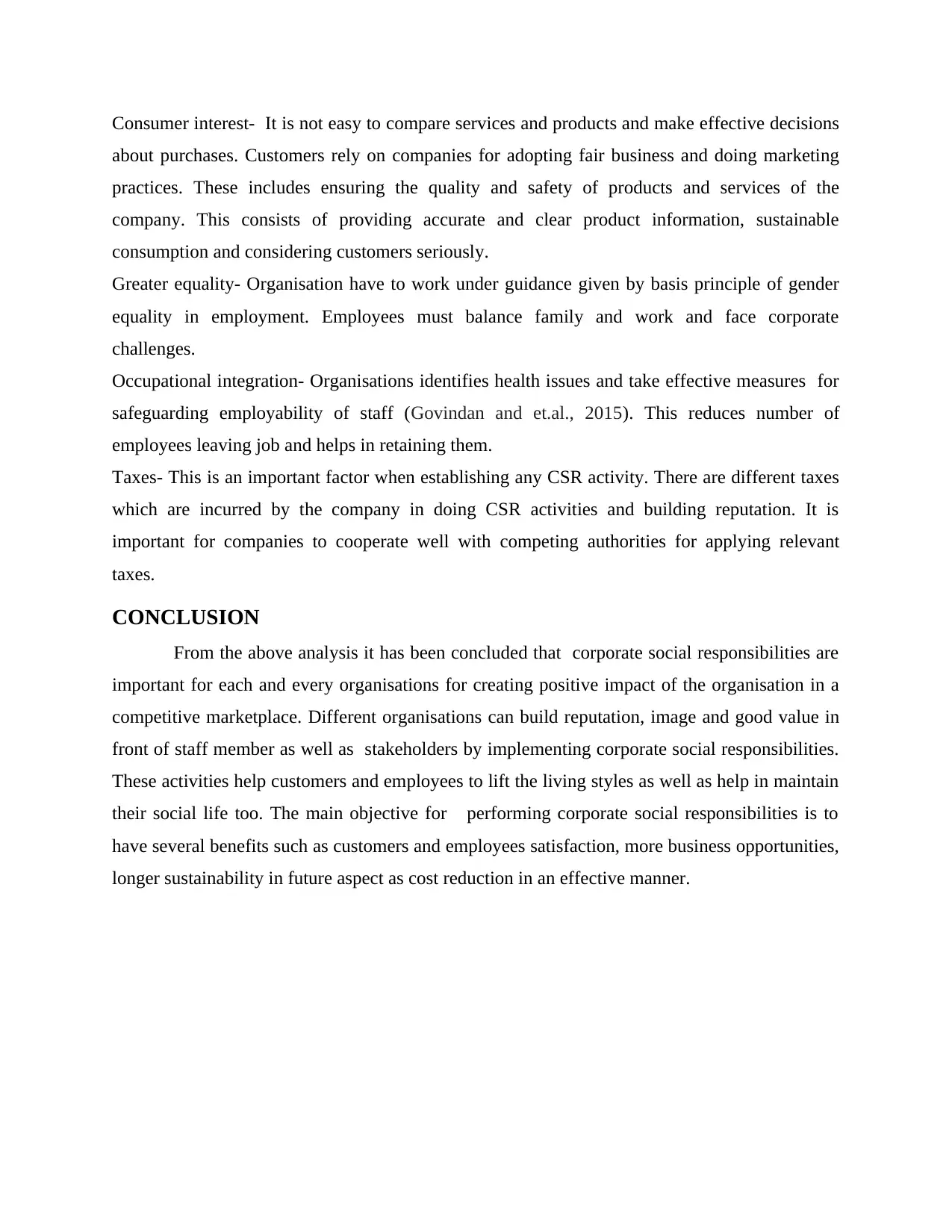
Consumer interest- It is not easy to compare services and products and make effective decisions
about purchases. Customers rely on companies for adopting fair business and doing marketing
practices. These includes ensuring the quality and safety of products and services of the
company. This consists of providing accurate and clear product information, sustainable
consumption and considering customers seriously.
Greater equality- Organisation have to work under guidance given by basis principle of gender
equality in employment. Employees must balance family and work and face corporate
challenges.
Occupational integration- Organisations identifies health issues and take effective measures for
safeguarding employability of staff (Govindan and et.al., 2015). This reduces number of
employees leaving job and helps in retaining them.
Taxes- This is an important factor when establishing any CSR activity. There are different taxes
which are incurred by the company in doing CSR activities and building reputation. It is
important for companies to cooperate well with competing authorities for applying relevant
taxes.
CONCLUSION
From the above analysis it has been concluded that corporate social responsibilities are
important for each and every organisations for creating positive impact of the organisation in a
competitive marketplace. Different organisations can build reputation, image and good value in
front of staff member as well as stakeholders by implementing corporate social responsibilities.
These activities help customers and employees to lift the living styles as well as help in maintain
their social life too. The main objective for performing corporate social responsibilities is to
have several benefits such as customers and employees satisfaction, more business opportunities,
longer sustainability in future aspect as cost reduction in an effective manner.
about purchases. Customers rely on companies for adopting fair business and doing marketing
practices. These includes ensuring the quality and safety of products and services of the
company. This consists of providing accurate and clear product information, sustainable
consumption and considering customers seriously.
Greater equality- Organisation have to work under guidance given by basis principle of gender
equality in employment. Employees must balance family and work and face corporate
challenges.
Occupational integration- Organisations identifies health issues and take effective measures for
safeguarding employability of staff (Govindan and et.al., 2015). This reduces number of
employees leaving job and helps in retaining them.
Taxes- This is an important factor when establishing any CSR activity. There are different taxes
which are incurred by the company in doing CSR activities and building reputation. It is
important for companies to cooperate well with competing authorities for applying relevant
taxes.
CONCLUSION
From the above analysis it has been concluded that corporate social responsibilities are
important for each and every organisations for creating positive impact of the organisation in a
competitive marketplace. Different organisations can build reputation, image and good value in
front of staff member as well as stakeholders by implementing corporate social responsibilities.
These activities help customers and employees to lift the living styles as well as help in maintain
their social life too. The main objective for performing corporate social responsibilities is to
have several benefits such as customers and employees satisfaction, more business opportunities,
longer sustainability in future aspect as cost reduction in an effective manner.
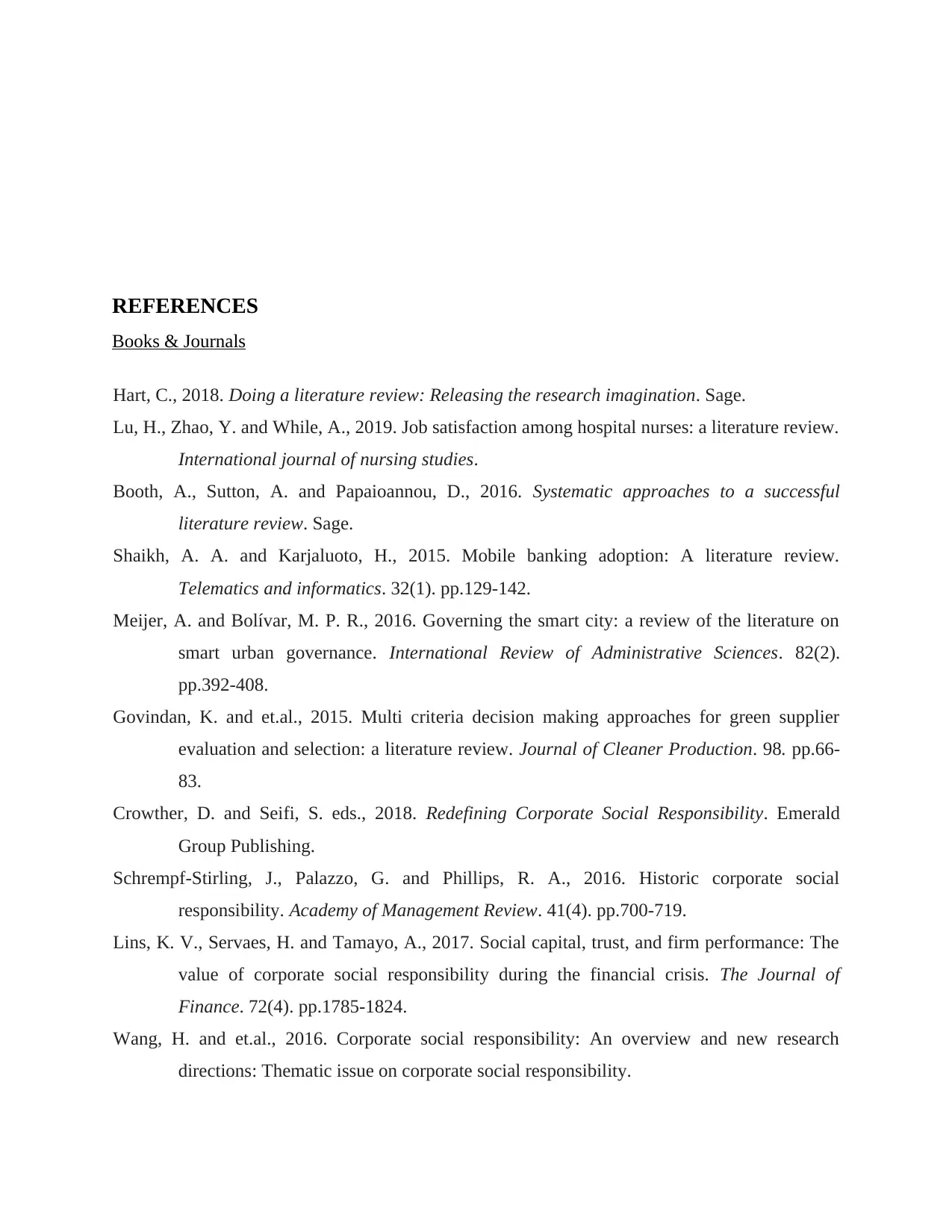
REFERENCES
Books & Journals
Hart, C., 2018. Doing a literature review: Releasing the research imagination. Sage.
Lu, H., Zhao, Y. and While, A., 2019. Job satisfaction among hospital nurses: a literature review.
International journal of nursing studies.
Booth, A., Sutton, A. and Papaioannou, D., 2016. Systematic approaches to a successful
literature review. Sage.
Shaikh, A. A. and Karjaluoto, H., 2015. Mobile banking adoption: A literature review.
Telematics and informatics. 32(1). pp.129-142.
Meijer, A. and Bolívar, M. P. R., 2016. Governing the smart city: a review of the literature on
smart urban governance. International Review of Administrative Sciences. 82(2).
pp.392-408.
Govindan, K. and et.al., 2015. Multi criteria decision making approaches for green supplier
evaluation and selection: a literature review. Journal of Cleaner Production. 98. pp.66-
83.
Crowther, D. and Seifi, S. eds., 2018. Redefining Corporate Social Responsibility. Emerald
Group Publishing.
Schrempf-Stirling, J., Palazzo, G. and Phillips, R. A., 2016. Historic corporate social
responsibility. Academy of Management Review. 41(4). pp.700-719.
Lins, K. V., Servaes, H. and Tamayo, A., 2017. Social capital, trust, and firm performance: The
value of corporate social responsibility during the financial crisis. The Journal of
Finance. 72(4). pp.1785-1824.
Wang, H. and et.al., 2016. Corporate social responsibility: An overview and new research
directions: Thematic issue on corporate social responsibility.
Books & Journals
Hart, C., 2018. Doing a literature review: Releasing the research imagination. Sage.
Lu, H., Zhao, Y. and While, A., 2019. Job satisfaction among hospital nurses: a literature review.
International journal of nursing studies.
Booth, A., Sutton, A. and Papaioannou, D., 2016. Systematic approaches to a successful
literature review. Sage.
Shaikh, A. A. and Karjaluoto, H., 2015. Mobile banking adoption: A literature review.
Telematics and informatics. 32(1). pp.129-142.
Meijer, A. and Bolívar, M. P. R., 2016. Governing the smart city: a review of the literature on
smart urban governance. International Review of Administrative Sciences. 82(2).
pp.392-408.
Govindan, K. and et.al., 2015. Multi criteria decision making approaches for green supplier
evaluation and selection: a literature review. Journal of Cleaner Production. 98. pp.66-
83.
Crowther, D. and Seifi, S. eds., 2018. Redefining Corporate Social Responsibility. Emerald
Group Publishing.
Schrempf-Stirling, J., Palazzo, G. and Phillips, R. A., 2016. Historic corporate social
responsibility. Academy of Management Review. 41(4). pp.700-719.
Lins, K. V., Servaes, H. and Tamayo, A., 2017. Social capital, trust, and firm performance: The
value of corporate social responsibility during the financial crisis. The Journal of
Finance. 72(4). pp.1785-1824.
Wang, H. and et.al., 2016. Corporate social responsibility: An overview and new research
directions: Thematic issue on corporate social responsibility.
⊘ This is a preview!⊘
Do you want full access?
Subscribe today to unlock all pages.

Trusted by 1+ million students worldwide
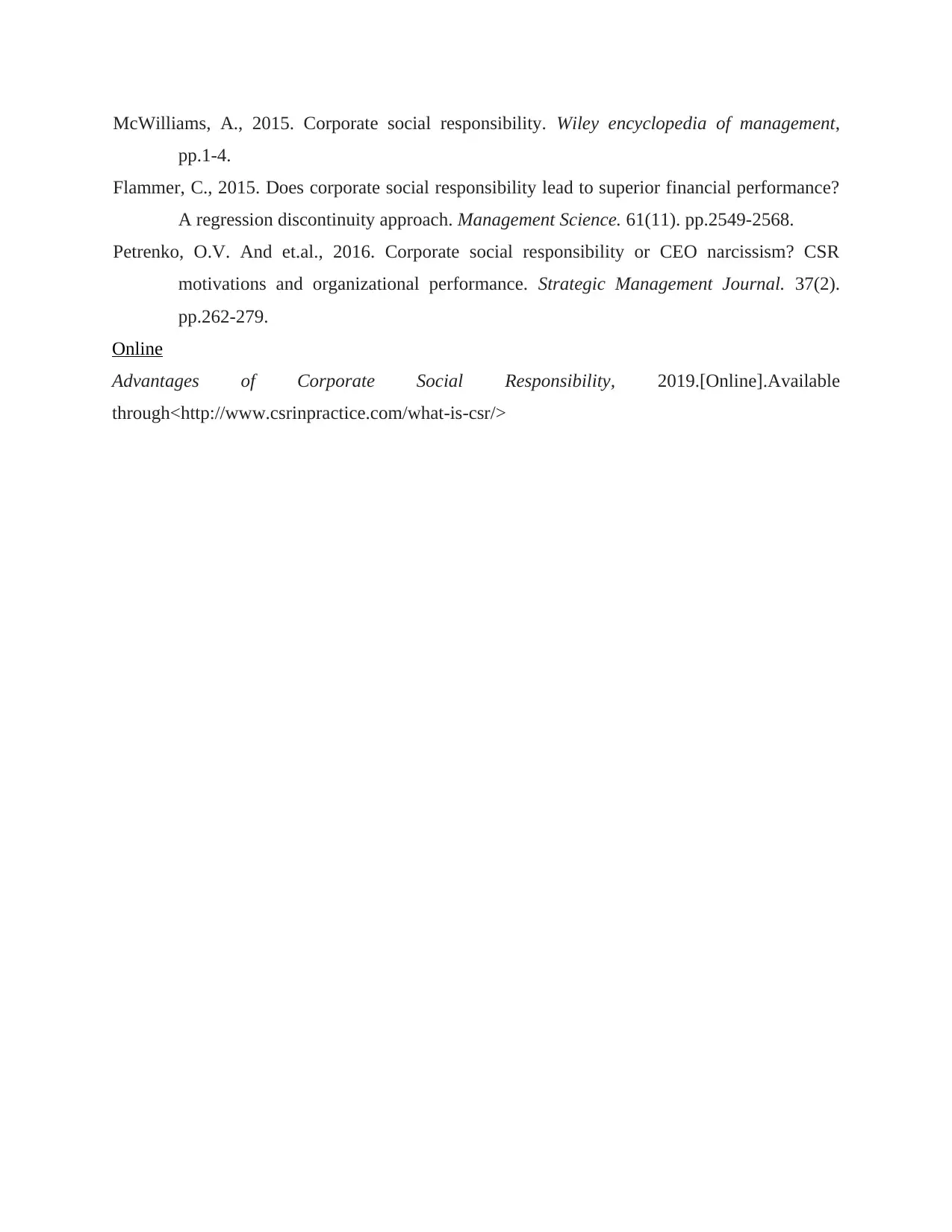
McWilliams, A., 2015. Corporate social responsibility. Wiley encyclopedia of management,
pp.1-4.
Flammer, C., 2015. Does corporate social responsibility lead to superior financial performance?
A regression discontinuity approach. Management Science. 61(11). pp.2549-2568.
Petrenko, O.V. And et.al., 2016. Corporate social responsibility or CEO narcissism? CSR
motivations and organizational performance. Strategic Management Journal. 37(2).
pp.262-279.
Online
Advantages of Corporate Social Responsibility, 2019.[Online].Available
through<http://www.csrinpractice.com/what-is-csr/>
pp.1-4.
Flammer, C., 2015. Does corporate social responsibility lead to superior financial performance?
A regression discontinuity approach. Management Science. 61(11). pp.2549-2568.
Petrenko, O.V. And et.al., 2016. Corporate social responsibility or CEO narcissism? CSR
motivations and organizational performance. Strategic Management Journal. 37(2).
pp.262-279.
Online
Advantages of Corporate Social Responsibility, 2019.[Online].Available
through<http://www.csrinpractice.com/what-is-csr/>
1 out of 10
Related Documents
Your All-in-One AI-Powered Toolkit for Academic Success.
+13062052269
info@desklib.com
Available 24*7 on WhatsApp / Email
![[object Object]](/_next/static/media/star-bottom.7253800d.svg)
Unlock your academic potential
Copyright © 2020–2025 A2Z Services. All Rights Reserved. Developed and managed by ZUCOL.





